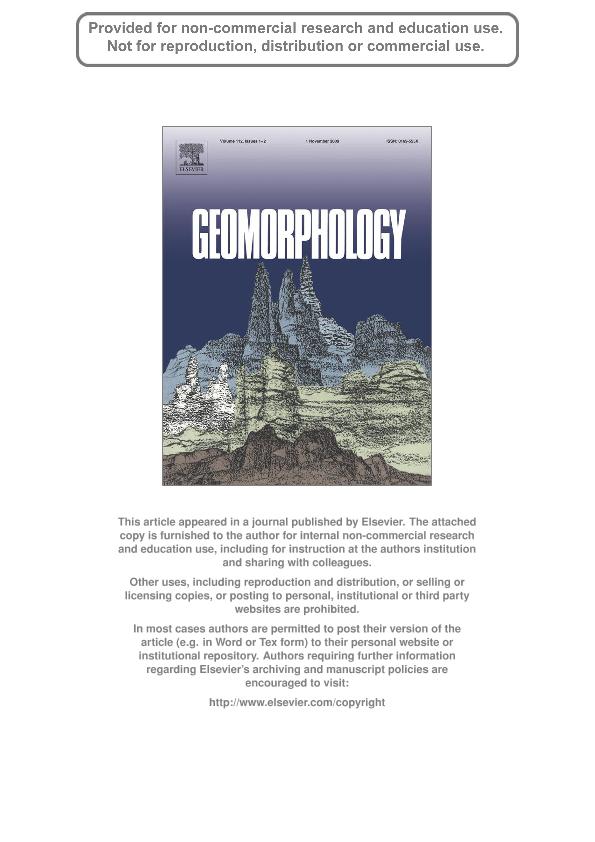Mostrar el registro sencillo del ítem
dc.contributor.author
Coronato, Andrea Maria Josefa

dc.contributor.author
Rabassa, Jorge Oscar

dc.contributor.author
Ponce, Juan Federico

dc.contributor.author
Seppälä, Matti
dc.date.available
2021-03-25T18:12:35Z
dc.date.issued
2009-11
dc.identifier.citation
Coronato, Andrea Maria Josefa; Rabassa, Jorge Oscar; Ponce, Juan Federico; Seppälä, Matti; Glacial geomorphology of the Pleistocene Lake Fagnano ice lobe, Tierra del Fuego, southern South America; Elsevier Science; Geomorphology; 112; 1-2; 11-2009; 67-81
dc.identifier.issn
0169-555X
dc.identifier.uri
http://hdl.handle.net/11336/128942
dc.description.abstract
A regional geomorphological study is presented of the southern and eastern coast of Lake Fagnano, one of the most extensive glacial areas of Tierra del Fuego Island, at the southernmost tip of South America. A palaeoglacial reconstruction is made, based on the location of erosional and depositional glacial landforms. The outlet glacier flowing eastwards from the Darwin Cordillera (Fuegian Andes, Chile) had more than 50 tributary glaciers. An alpine-type landscape, including arêtes, cirques, truncated spurs and hanging valleys developed in the western region of the present lake, whereas a piedmont-type landscape including lateral moraines, glaciofluvial and glaciolacustrine terraces and an ice-disintegration landscape developed in the eastern region. The glacier spread over the low ranges and lowlands through three different lobes, and was drained by four main outwash basins, directly into the Atlantic Ocean. The ice-covered area is estimated at 4000 km2; the maximum length of the main lobe at 132 km, and the general slope at 8°. Four terminal positions of the glacier were recognized and related to the Inútil Bay and Beagle Channel glacial areas, located to the north and south, respectively. 14C dates from basal peats show that most of the area, especially the easternmost part and the southern coast, were free of ice by 12,300 years B.P. Fossil peat contained in the lower basal till deposits yield 14C dates of 31,000-48,200 years B.P., indicating that a glacial advance occurred in the area prior to the Last Glacial Maximum (ca. 25,000-23,000 cal. years B.P.).
dc.format
application/pdf
dc.language.iso
eng
dc.publisher
Elsevier Science

dc.rights
info:eu-repo/semantics/openAccess
dc.rights.uri
https://creativecommons.org/licenses/by-nc-sa/2.5/ar/
dc.subject
GLACIAL LANDFORMS
dc.subject
LAKE FAGNANO
dc.subject
LAST GLACIAL MAXIMUM
dc.subject
LATE GLACIAL
dc.subject
PALAEOGLACIERS
dc.subject
SOUTH AMERICA
dc.subject.classification
Geografía Física

dc.subject.classification
Ciencias de la Tierra y relacionadas con el Medio Ambiente

dc.subject.classification
CIENCIAS NATURALES Y EXACTAS

dc.title
Glacial geomorphology of the Pleistocene Lake Fagnano ice lobe, Tierra del Fuego, southern South America
dc.type
info:eu-repo/semantics/article
dc.type
info:ar-repo/semantics/artículo
dc.type
info:eu-repo/semantics/publishedVersion
dc.date.updated
2021-03-12T19:18:19Z
dc.journal.volume
112
dc.journal.number
1-2
dc.journal.pagination
67-81
dc.journal.pais
Países Bajos

dc.journal.ciudad
Amsterdam
dc.description.fil
Fil: Coronato, Andrea Maria Josefa. Consejo Nacional de Investigaciones Científicas y Técnicas. Centro Austral de Investigaciones Científicas; Argentina
dc.description.fil
Fil: Rabassa, Jorge Oscar. Consejo Nacional de Investigaciones Científicas y Técnicas. Centro Austral de Investigaciones Científicas; Argentina
dc.description.fil
Fil: Ponce, Juan Federico. Consejo Nacional de Investigaciones Científicas y Técnicas. Centro Austral de Investigaciones Científicas; Argentina
dc.description.fil
Fil: Seppälä, Matti. University of Helsinki; Finlandia
dc.journal.title
Geomorphology

dc.relation.alternativeid
info:eu-repo/semantics/altIdentifier/url/https://www.sciencedirect.com/science/article/abs/pii/S0169555X09002050
dc.relation.alternativeid
info:eu-repo/semantics/altIdentifier/doi/https://doi.org/10.1016/j.geomorph.2009.05.005
Archivos asociados
